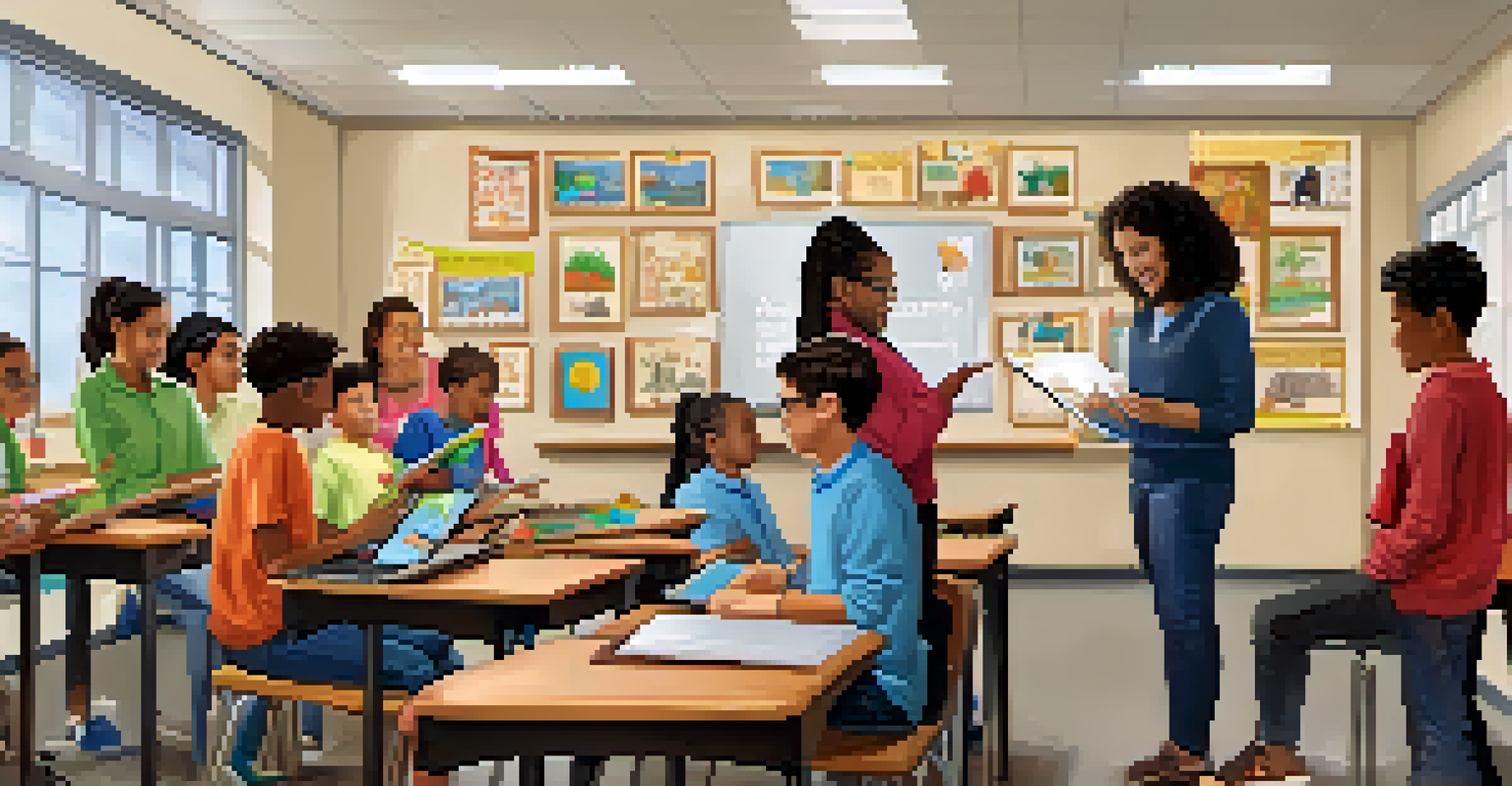Designing for Diverse Learners: Inclusivity in Education

Understanding the Importance of Inclusivity in Education
Inclusivity in education means recognizing and valuing the diverse backgrounds and abilities of all learners. It is essential because every student brings unique perspectives and experiences to the classroom, enriching the learning environment. When we embrace inclusivity, we create a space where all students feel valued and empowered to participate fully in their education.
In diversity, there is beauty and there is strength.
Moreover, inclusive education fosters a sense of belonging among students, which can significantly boost their self-esteem and motivation. When learners see themselves reflected in the curriculum and teaching methods, they are more likely to engage and excel. This engagement is crucial for academic success and lifelong learning.
Lastly, inclusivity prepares students for a diverse world beyond the classroom. By learning alongside peers from different backgrounds, students develop empathy and teamwork skills that are essential in today's global society. Ultimately, inclusive education is not just about accommodating differences; it's about celebrating them.
Identifying Diverse Learning Needs in the Classroom
Recognizing diverse learning needs starts with understanding that every student learns differently. Factors such as cultural background, language proficiency, and learning disabilities all play a role in how students absorb information. Teachers can begin by assessing their students' strengths and challenges through various methods, such as surveys, observations, and one-on-one discussions.

It's also important to create an open environment where students feel comfortable sharing their needs and preferences. Encouraging them to express how they learn best can provide invaluable insights for educators. This dialogue helps build trust and allows educators to tailor their approaches to meet individual learning styles.
Embrace Inclusivity for Success
Inclusivity in education enriches the learning environment by valuing diverse backgrounds and fostering engagement among all students.
Using tools like learning profiles can help teachers keep track of students' unique needs and preferences. By regularly updating these profiles, educators can adapt their teaching methods and materials to ensure every student has an equal opportunity to succeed. This proactive approach to identifying diverse needs lays the foundation for effective inclusive practices.
Implementing Universal Design for Learning (UDL)
Universal Design for Learning (UDL) is a framework aimed at optimizing teaching and learning for all individuals by providing multiple means of engagement, representation, and action. This approach encourages educators to consider the diverse ways students learn and to provide various options for accessing content. For instance, using videos, infographics, and hands-on activities can cater to different learning preferences.
The function of education is to teach one to think intensively and to think critically. Intelligence plus character – that is the goal of true education.
By incorporating UDL principles, teachers can create a more flexible and responsive learning environment. This flexibility not only aids students with specific learning needs but also benefits all learners by offering choices that enhance engagement. For example, allowing students to choose between writing a report or creating a presentation can make the learning experience more meaningful.
Additionally, UDL promotes self-regulation by encouraging students to set their own goals and monitor their progress. This empowerment leads to greater motivation and investment in their learning journey. Ultimately, implementing UDL principles can transform classrooms into inclusive spaces where every learner thrives.
Creating Culturally Responsive Teaching Practices
Culturally responsive teaching recognizes the importance of including students' cultural references in all aspects of learning. This approach values the diverse backgrounds of students and integrates their experiences into the curriculum. For example, using literature from various cultures can help students see themselves in the material and promote a deeper understanding of different perspectives.
Moreover, culturally responsive teaching encourages educators to reflect on their own biases and assumptions. By understanding their cultural identities, teachers can better connect with their students and create a more inclusive environment. This self-awareness fosters relationships built on respect and understanding, which is crucial for effective teaching.
Utilize UDL for Diverse Learning
Implementing Universal Design for Learning (UDL) allows educators to cater to various learning preferences, enhancing engagement and success.
Incorporating culturally relevant examples and practices can also enhance student engagement. When learners see their culture reflected in the classroom, they are more likely to participate actively. This connection not only enriches the learning experience but also promotes a sense of belonging among all students.
Utilizing Assistive Technology for Enhanced Learning
Assistive technology plays a vital role in supporting diverse learners by providing tools that enhance accessibility and engagement. From text-to-speech software to interactive apps, these technologies can help students overcome barriers to learning. For instance, a student with dyslexia may benefit from audio versions of texts, allowing them to engage with the material more effectively.
Moreover, using assistive technology can foster independence among students with disabilities. Tools like speech recognition software enable them to express their ideas without being hindered by writing difficulties. By promoting self-sufficiency, educators empower learners to take control of their educational journeys.
It's important for educators to stay informed about the latest assistive technologies available. Providing training and resources for both teachers and students ensures that everyone can make the most of these tools. When integrated thoughtfully, assistive technology can transform the learning experience for diverse learners.
Building a Supportive Classroom Community
Creating a supportive classroom community is essential for fostering inclusivity. This involves cultivating an atmosphere where students feel safe to express themselves and support one another. Activities like team-building exercises and group discussions can help build trust among students, encouraging them to collaborate and learn from each other.
Moreover, educators play a crucial role in modeling inclusive behavior. By demonstrating respect for all students and celebrating their differences, teachers set the tone for the classroom. When students observe their teachers valuing diversity, they are more likely to adopt similar attitudes and behaviors.
Build Community for Support
Creating a supportive classroom community encourages collaboration and respect, making inclusivity a shared value among students.
Encouraging peer mentorship can also strengthen the classroom community. Pairing students with different strengths can facilitate learning and create bonds, leading to a more cooperative environment. Ultimately, a supportive classroom community enhances the learning experience for all students, making inclusivity a shared value.
Continuous Reflection and Improvement in Inclusive Practices
Inclusivity in education is an ongoing journey that requires continuous reflection and improvement. Educators should regularly assess the effectiveness of their teaching strategies and be open to feedback from students and colleagues. This reflective practice allows teachers to identify areas for growth and adapt their approaches to better serve diverse learners.
Additionally, professional development opportunities can provide educators with the skills and knowledge needed to implement inclusive practices effectively. Workshops, conferences, and collaborative learning communities can help teachers stay updated on the latest research and strategies in inclusive education. Investing in professional growth ultimately benefits both educators and students.

Finally, fostering a culture of inclusivity within the school community is essential. Engaging parents, administrators, and community members in discussions about inclusivity can create a shared commitment to supporting diverse learners. Through collaboration and continuous improvement, we can ensure that every student has the opportunity to thrive in an inclusive educational environment.